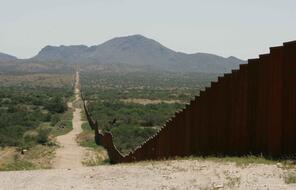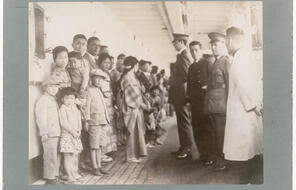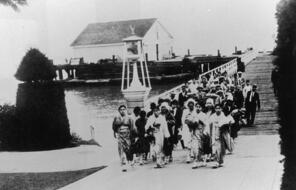Historical Context
The history of the Angel Island Immigration Station, which operated from 1910 to 1940, provides an important case study for exploring how borders of belonging have shaped the terms of membership in American society throughout history. Most Americans think of the Ellis Island Immigration Station in New York as a haven for “huddled masses yearning to breathe free,” and the Angel Island Immigration Station is often characterized as its West Coast counterpart. While both stations served to restrict immigration, immigrants passing through Angel Island faced much more exclusionary policies and harsher treatment. The station was initially built to enforce the laws of Chinese exclusion, which banned all Chinese laborers from immigrating to the country and declared Chinese immigrants ineligible for US citizenship. Nearly overnight, the nation went from having an “open door” policy toward immigrants to excluding an entire group of people on the basis of race and national origin.
Historian Erika Lee compares Angel Island to Ellis Island:
While popularly called the “Ellis Island of the West,” the immigration station on Angel Island was in fact very different from its counterpart in New York. Ellis Island, mainly a processing center for European immigrants, was governed by American immigration laws that restricted but did not exclude European immigrants. . . . Immigrants on Ellis Island usually only spent a few hours at the island depot, whereas Asians, and particularly Chinese, on Angel Island counted their detention in weeks, months, and even years. Ellis Island was a processing station of entry, but Angel Island’s purpose was to keep immigrants out.
In the face of tremendous barriers built by exclusion, Chinese immigrants still found ways to make a life in the United States. In this inquiry, students reflect on the choices and dilemmas of immigrants who entered the country through Angel Island using fraudulent papers, under what is known as the “paper son” system. Students will explore how the actions of “paper sons and daughters” involved making a claim to their rightful belonging in American society and resisting unjust laws intended to keep them out. These choices, which ensured that their family members and future generations could settle in the nation, represented a direct challenge to the exclusionary view of American identity embedded in the nation’s immigration laws. As one Chinese American merchant who helped paper sons enter the country explained, “God never said that the Chinaman shouldn’t come to this country.”
Despite this resistance, the policy of Chinese exclusion led to an increasingly narrow definition of who could become American. Chinese exclusion set a precedent of racially targeted exclusions that sharply limited the immigration of other groups, including all Asians, Africans, and Europeans from southern and eastern Europe. Many of these groups immigrated to the United States through Angel Island and experienced treatment similar to Chinese immigrants during their detention. According to historian Roger Daniels, the Exclusion Act was “the pivot on which all American immigration policy turned, the hinge on which Emma Lazarus’s ‘Golden Door’ began to swing toward a closed position.”
That door would stay closed to Chinese immigrants, and eventually all Asian and southern and eastern European immigrants, until the post–World War II era and passage of the Immigration and Nationality Act of 1965.
Broadening the Understanding of Borders
This inquiry asks students to draw connections between the history of immigration through Angel Island and the borders within American society that exist today, and to examine how communities can harness the power of history to challenge these borders. Students will connect recent racism against Asian and Pacific Islander (API) communities in the context of the coronavirus pandemic to longstanding racial prejudices against Asians living in the United States. They will also explore a grassroots effort to rename a street in downtown Berkeley after Kala Bagai, a South Asian immigrant who was detained with her family at the Angel Island Immigration Station and became a community and immigrant-rights activist.
Studying US history through the lens of borders and belonging provides an important opportunity to connect to students’ lived experiences. Adolescence is a time when two tasks take on special importance: determining our own individual identity and figuring out where and how we belong. Adolescents are in the process of becoming more attuned to their own social identities and to the positive and negative meanings that may be attached to them. Moreover, winning respect from their peers and acceptance in social groups is of paramount importance to them. They are thus developmentally primed to explore the divisions that separate “us” on one side of a boundary from “them” on the other side in their US history courses.
Boundaries are fixtures of students’ lives. Whether crossing a geopolitical border, navigating between the digital and “real” world, or traveling from their neighborhood to school, students are constantly encountering borders and boundaries. Young people can greatly benefit from thinking deeply and critically about the concept of borders: how we negotiate them and, in moments when they are meant to limit us, how we can challenge and rise above them.


















